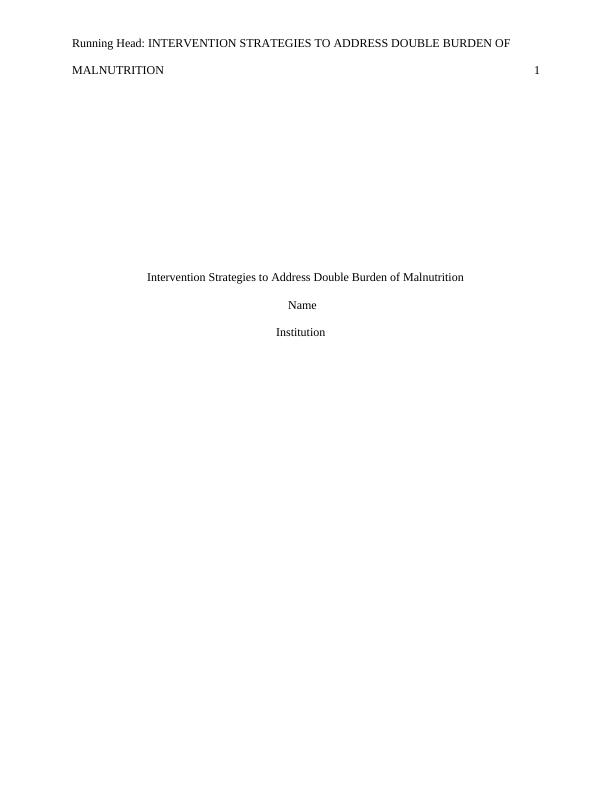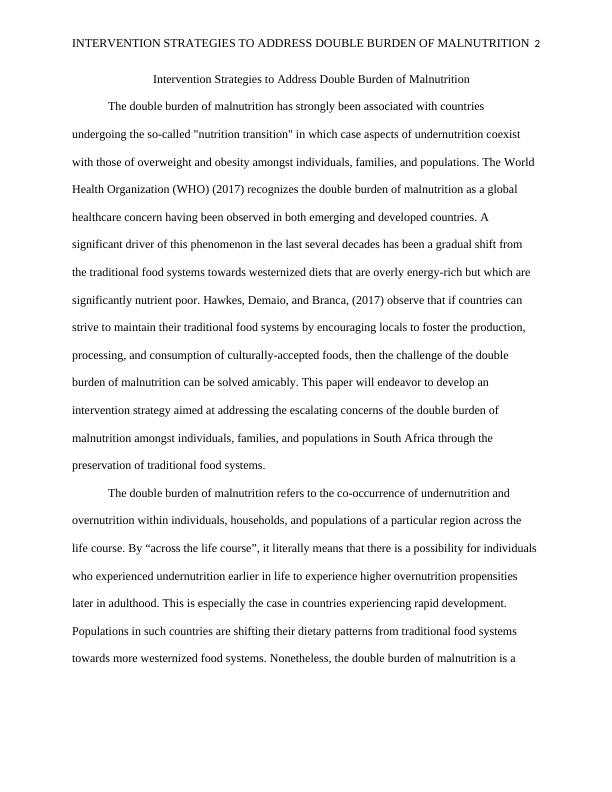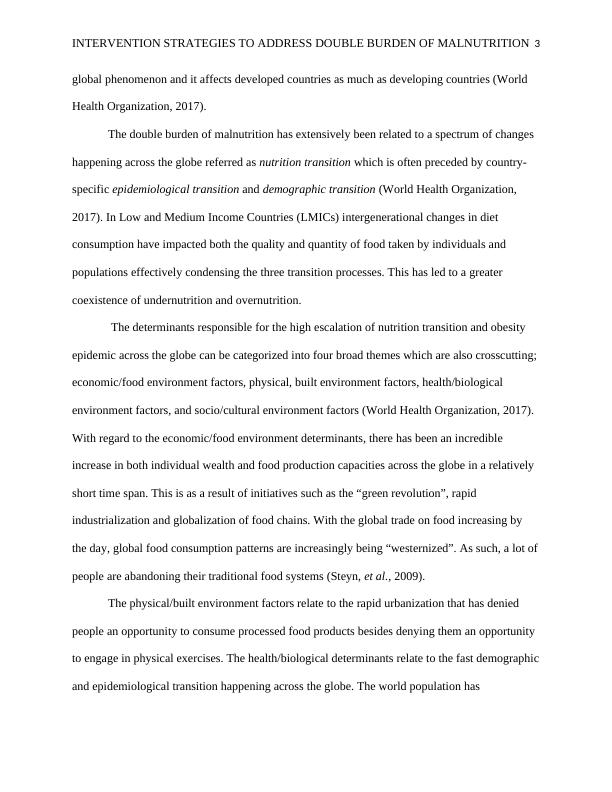Intervention Strategies to Address Double Burden of Malnutrition
Added on 2023-06-03
13 Pages4044 Words151 Views
Running Head: INTERVENTION STRATEGIES TO ADDRESS DOUBLE BURDEN OF
MALNUTRITION 1
Intervention Strategies to Address Double Burden of Malnutrition
Name
Institution
MALNUTRITION 1
Intervention Strategies to Address Double Burden of Malnutrition
Name
Institution

INTERVENTION STRATEGIES TO ADDRESS DOUBLE BURDEN OF MALNUTRITION 2
Intervention Strategies to Address Double Burden of Malnutrition
The double burden of malnutrition has strongly been associated with countries
undergoing the so-called "nutrition transition" in which case aspects of undernutrition coexist
with those of overweight and obesity amongst individuals, families, and populations. The World
Health Organization (WHO) (2017) recognizes the double burden of malnutrition as a global
healthcare concern having been observed in both emerging and developed countries. A
significant driver of this phenomenon in the last several decades has been a gradual shift from
the traditional food systems towards westernized diets that are overly energy-rich but which are
significantly nutrient poor. Hawkes, Demaio, and Branca, (2017) observe that if countries can
strive to maintain their traditional food systems by encouraging locals to foster the production,
processing, and consumption of culturally-accepted foods, then the challenge of the double
burden of malnutrition can be solved amicably. This paper will endeavor to develop an
intervention strategy aimed at addressing the escalating concerns of the double burden of
malnutrition amongst individuals, families, and populations in South Africa through the
preservation of traditional food systems.
The double burden of malnutrition refers to the co-occurrence of undernutrition and
overnutrition within individuals, households, and populations of a particular region across the
life course. By “across the life course”, it literally means that there is a possibility for individuals
who experienced undernutrition earlier in life to experience higher overnutrition propensities
later in adulthood. This is especially the case in countries experiencing rapid development.
Populations in such countries are shifting their dietary patterns from traditional food systems
towards more westernized food systems. Nonetheless, the double burden of malnutrition is a
Intervention Strategies to Address Double Burden of Malnutrition
The double burden of malnutrition has strongly been associated with countries
undergoing the so-called "nutrition transition" in which case aspects of undernutrition coexist
with those of overweight and obesity amongst individuals, families, and populations. The World
Health Organization (WHO) (2017) recognizes the double burden of malnutrition as a global
healthcare concern having been observed in both emerging and developed countries. A
significant driver of this phenomenon in the last several decades has been a gradual shift from
the traditional food systems towards westernized diets that are overly energy-rich but which are
significantly nutrient poor. Hawkes, Demaio, and Branca, (2017) observe that if countries can
strive to maintain their traditional food systems by encouraging locals to foster the production,
processing, and consumption of culturally-accepted foods, then the challenge of the double
burden of malnutrition can be solved amicably. This paper will endeavor to develop an
intervention strategy aimed at addressing the escalating concerns of the double burden of
malnutrition amongst individuals, families, and populations in South Africa through the
preservation of traditional food systems.
The double burden of malnutrition refers to the co-occurrence of undernutrition and
overnutrition within individuals, households, and populations of a particular region across the
life course. By “across the life course”, it literally means that there is a possibility for individuals
who experienced undernutrition earlier in life to experience higher overnutrition propensities
later in adulthood. This is especially the case in countries experiencing rapid development.
Populations in such countries are shifting their dietary patterns from traditional food systems
towards more westernized food systems. Nonetheless, the double burden of malnutrition is a

INTERVENTION STRATEGIES TO ADDRESS DOUBLE BURDEN OF MALNUTRITION 3
global phenomenon and it affects developed countries as much as developing countries (World
Health Organization, 2017).
The double burden of malnutrition has extensively been related to a spectrum of changes
happening across the globe referred as nutrition transition which is often preceded by country-
specific epidemiological transition and demographic transition (World Health Organization,
2017). In Low and Medium Income Countries (LMICs) intergenerational changes in diet
consumption have impacted both the quality and quantity of food taken by individuals and
populations effectively condensing the three transition processes. This has led to a greater
coexistence of undernutrition and overnutrition.
The determinants responsible for the high escalation of nutrition transition and obesity
epidemic across the globe can be categorized into four broad themes which are also crosscutting;
economic/food environment factors, physical, built environment factors, health/biological
environment factors, and socio/cultural environment factors (World Health Organization, 2017).
With regard to the economic/food environment determinants, there has been an incredible
increase in both individual wealth and food production capacities across the globe in a relatively
short time span. This is as a result of initiatives such as the “green revolution”, rapid
industrialization and globalization of food chains. With the global trade on food increasing by
the day, global food consumption patterns are increasingly being “westernized”. As such, a lot of
people are abandoning their traditional food systems (Steyn, et al., 2009).
The physical/built environment factors relate to the rapid urbanization that has denied
people an opportunity to consume processed food products besides denying them an opportunity
to engage in physical exercises. The health/biological determinants relate to the fast demographic
and epidemiological transition happening across the globe. The world population has
global phenomenon and it affects developed countries as much as developing countries (World
Health Organization, 2017).
The double burden of malnutrition has extensively been related to a spectrum of changes
happening across the globe referred as nutrition transition which is often preceded by country-
specific epidemiological transition and demographic transition (World Health Organization,
2017). In Low and Medium Income Countries (LMICs) intergenerational changes in diet
consumption have impacted both the quality and quantity of food taken by individuals and
populations effectively condensing the three transition processes. This has led to a greater
coexistence of undernutrition and overnutrition.
The determinants responsible for the high escalation of nutrition transition and obesity
epidemic across the globe can be categorized into four broad themes which are also crosscutting;
economic/food environment factors, physical, built environment factors, health/biological
environment factors, and socio/cultural environment factors (World Health Organization, 2017).
With regard to the economic/food environment determinants, there has been an incredible
increase in both individual wealth and food production capacities across the globe in a relatively
short time span. This is as a result of initiatives such as the “green revolution”, rapid
industrialization and globalization of food chains. With the global trade on food increasing by
the day, global food consumption patterns are increasingly being “westernized”. As such, a lot of
people are abandoning their traditional food systems (Steyn, et al., 2009).
The physical/built environment factors relate to the rapid urbanization that has denied
people an opportunity to consume processed food products besides denying them an opportunity
to engage in physical exercises. The health/biological determinants relate to the fast demographic
and epidemiological transition happening across the globe. The world population has

INTERVENTION STRATEGIES TO ADDRESS DOUBLE BURDEN OF MALNUTRITION 4
dramatically increased and non-communicable diseases are replacing infectious diseases as a
major cause of death. The increase in population does not measure up with the increase in food
production in some parts of the world thereby leading to undernutrition. Lastly, the socio/cultural
landscape shapes populations food consumption patterns in many different ways. In urban areas,
people are inclined at consuming processed food products which leads to overnutrition while in
rural areas many people may be undernourished as a result of clinging on cultural food
consumption orientations (Prentice, 2018).
In the last several decades, the term malnutrition has been used to refer to undernutrition
following the earlier focus of nutrition research on protein-calorie malnutrition (PCM).
However, the World Health Organization defines malnutrition to mean either nutritional
deficiencies or excesses. As such the etiology and epidemiology of the double burden of
malnutrition is twofold since some sections of the population are malnourished (underweight)
while others are overnourished (overweight) (Delisle, 2008).
Undernutrition is exhibited by stunted growth in children and underweight individuals.
This is as a result of insufficient intake or poor biological use of nutrients. Undernutrition
significantly impairs the functioning of vital body functions, make victims look emaciated
besides impairing with growth and development especially in children. Underweight is measured
through either low weight-for-age or low weight for height (wasting) as well as low length-for-
age (stunting). Undernutrition is majorly caused by lack of sufficient intake of both macro and
micronutrients such as iron, zinc, iodine, calcium, and vitamins. On the other hand, overnutrition
results when individuals consume nutrients in excess amounts or fail to balance off their intake
potentially leading to impaired body functions as well as obesity and being overweight.
Overweight is deduced by measuring Body Mass Index against age or relating weight against the
dramatically increased and non-communicable diseases are replacing infectious diseases as a
major cause of death. The increase in population does not measure up with the increase in food
production in some parts of the world thereby leading to undernutrition. Lastly, the socio/cultural
landscape shapes populations food consumption patterns in many different ways. In urban areas,
people are inclined at consuming processed food products which leads to overnutrition while in
rural areas many people may be undernourished as a result of clinging on cultural food
consumption orientations (Prentice, 2018).
In the last several decades, the term malnutrition has been used to refer to undernutrition
following the earlier focus of nutrition research on protein-calorie malnutrition (PCM).
However, the World Health Organization defines malnutrition to mean either nutritional
deficiencies or excesses. As such the etiology and epidemiology of the double burden of
malnutrition is twofold since some sections of the population are malnourished (underweight)
while others are overnourished (overweight) (Delisle, 2008).
Undernutrition is exhibited by stunted growth in children and underweight individuals.
This is as a result of insufficient intake or poor biological use of nutrients. Undernutrition
significantly impairs the functioning of vital body functions, make victims look emaciated
besides impairing with growth and development especially in children. Underweight is measured
through either low weight-for-age or low weight for height (wasting) as well as low length-for-
age (stunting). Undernutrition is majorly caused by lack of sufficient intake of both macro and
micronutrients such as iron, zinc, iodine, calcium, and vitamins. On the other hand, overnutrition
results when individuals consume nutrients in excess amounts or fail to balance off their intake
potentially leading to impaired body functions as well as obesity and being overweight.
Overweight is deduced by measuring Body Mass Index against age or relating weight against the

End of preview
Want to access all the pages? Upload your documents or become a member.
Related Documents
PUBH642 - Global Nutrition and Food Securitylg...
|11
|3167
|61
005GSID - Global Nutrition and Food Securitylg...
|14
|3779
|87
Dual burden of malnutrition in Indonesialg...
|15
|3737
|55
Double burden of malnutrition PDFlg...
|13
|4178
|210
Diet and Nutrition of Aboriginal and Torres Strait islander3 Case Study 2022lg...
|6
|1363
|22
Double burden of malnutritionlg...
|17
|4296
|49